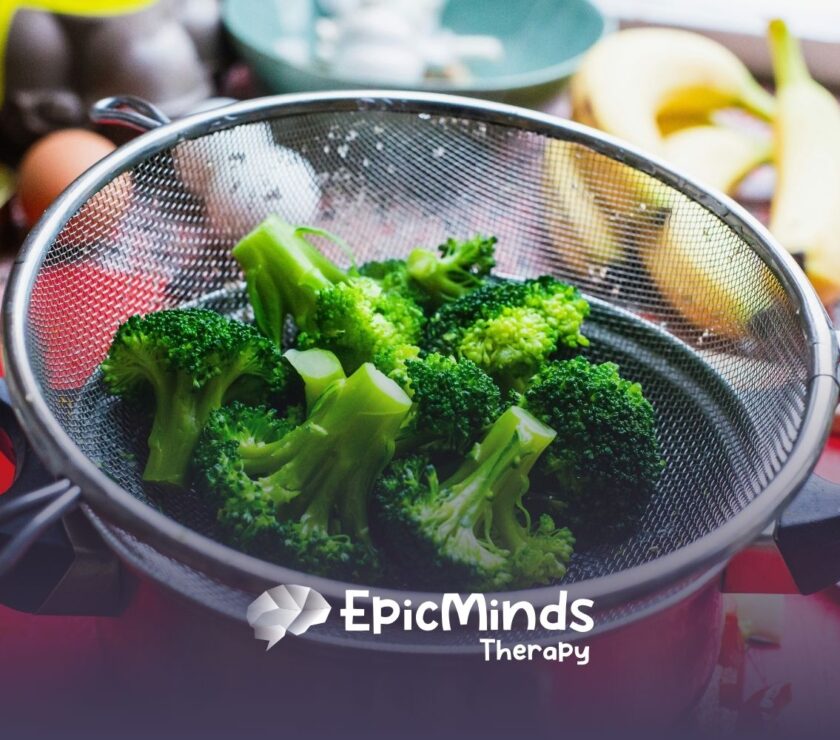Sulforaphane autism treatment has emerged as a promising complementary approach alongside standard therapies for Autism Spectrum Disorder (ASD). Recent data indicate that roughly 1 in 59 children in the U.S. receives an ASD diagnosis. As families and professionals explore ways to support social responsiveness, communication, and behavior, sulforaphane’s antioxidant and anti-inflammatory properties have drawn increasing interest. This guide reviews the compound’s background, biological action, key clinical findings, dosing strategies, safety profile, and practical considerations for parents and caregivers.
Sulforaphane Overview and Background
Sulforaphane is an isothiocyanate derived from glucoraphanin, a compound abundant in cruciferous vegetables, including broccoli sprouts, Brussels sprouts, and kale. When plant tissue is crushed or chewed, the enzyme myrosinase converts glucoraphanin into sulforaphane (often abbreviated SFN). In dietary supplement form, SFN is typically delivered as a concentrated broccoli seed or sprout extract.
As a complementary and alternative medicine option, SFN is not approved by the U.S. Food and Drug Administration for ASD treatment. However, its broad biological effects, including antioxidant, anti-inflammatory, and neuroprotective actions, have prompted multiple clinical trials. Families often consider SFN alongside applied behavior analysis (ABA), speech therapy, and educational supports to address core ASD symptoms.
Source and Chemistry
- Found in high concentrations in broccoli sprouts (up to 100 times more than mature broccoli)
- Synthesized when glucoraphanin and myrosinase interact
- Available as oral powders, capsules, or liquid extracts
Complementary Role in ASD
While behavioral interventions remain the cornerstone of ASD care, early studies suggest that SFN may enhance treatment outcomes by targeting physiological pathways linked to symptom severity.
Understanding Mechanism of Action
Sulforaphane’s potential benefits in ASD stem from several interrelated biological pathways. By modulating oxidative stress, inflammation, and cellular defense systems, SFN may support neural function and behavior.
Antioxidant Activity
Sulforaphane activates the Nrf2 (nuclear factor erythroid 2-related factor 2) pathway, which regulates the expression of antioxidant enzymes. This leads to:
- Increased glutathione synthesis, a key cellular antioxidant
- Enhanced protection against reactive oxygen species
- Preservation of mitochondrial integrity
Anti-Inflammatory Pathways
SFN has been shown to reduce levels of pro-inflammatory cytokines such as interleukin-6 (IL-6) and tumor necrosis factor-alpha (TNF-α). By dampening chronic inflammation in the brain, it may alleviate irritability and repetitive behaviors.
Neuroprotective Effects
Animal studies demonstrate that SFN can cross the blood-brain barrier and accumulate in neural tissue. Its neuroprotective actions include:
- Protection against tissue damage
- Maintenance of mitochondrial function
- Regulation of neurotransmitter balance
Reviewing Clinical Research Findings
Several controlled trials and open-label studies have evaluated sulforaphane for ASD, with most reporting positive outcomes in social interaction, communication, and behavior.
Double-Blind Placebo-Controlled Trials
- An 18-week trial with 47 young men (ages 13–27) reported significant improvements in Aberrant Behavior Checklist (ABC) and Social Responsiveness Scale (SRS) scores for the SFN group compared to placebo.
- A 30-week study involving 50 participants showed reduced irritability, lethargy, stereotypes, and hyperactivity in those receiving SFN versus control.
- A third randomized trial documented gains in social responsiveness and verbal communication after daily supplementation.
Open-Label Supplementation Studies
- A 12-week study of 15 children found a 7.1-point decrease in ABC and a 9.7-point drop in SRS scores using a broccoli seed blend (2.5 µmol per pound of body weight).
- A 28-week trial with six participants observed improvements in 80 percent of assessed ASD attributes.
Systematic Review Summary
A recent review encompassing five clinical trials confirmed a positive correlation between SFN use and enhancements in behavior and cognitive function, noting minimal adverse effects.
Key Trial Comparisons
| Study Type | Participants | Duration | Key Findings |
| Double-Blind RCT | 47 males (13–27 years) | 18 weeks | Improved ABC and SRS scores |
| Double-Blind RCT | 50 youth and adults | 30 weeks | Reduced irritability, hyperactivity, and social withdrawal |
| Open-Label Supplementation | 15 children | 12 weeks | Decreased ABC by 7.1 points and SRS by 9.7 points |
| Open-Label Supplementation | 6 participants | 28 weeks | Positive changes in 80 percent of ASD attributes |
Potential Benefits for Autism
Across trials, SFN therapy has been linked to meaningful improvements in core ASD domains.
Social Interaction Improvements
Participants receiving SFN often show:
- More eye contact
- Increased social initiation
- Enhanced peer engagement
Verbal Communication Gains
Reported language benefits include:
- Expanded vocabulary use
- Clearer sentence structure
- Improved conversational reciprocity
Behavioral Changes
Caregivers note reductions in:
- Irritability and aggression
- Repetitive motor movements
- Social withdrawal
These benefits may emerge after 6–12 weeks of consistent supplementation.
Dosage and Administration Guidelines
Determining the right daily dose and delivery method is critical for safety and effectiveness.
Dosage Based on Body Weight
Clinical trials tailored SFN doses to body weight, commonly using 2.5 µmol per pound. Approximate daily amounts include:
| Body Weight | Approximate Dose |
| < 50 lbs | 125 µmol |
| 50–100 lbs | 250 µmol |
| 100–150 lbs | 375 µmol |
| > 150 lbs | 500 µmol |
Dosing adjustments may be required based on individual response and medical advice.
Delivery Methods
Common forms of sulforaphane supplements:
- Broccoli sprout powder with active myrosinase
- Standardized seed extracts in capsule form
- Liquid concentrates or tinctures
Product quality varies; third-party testing for glucoraphanin content and myrosinase activity ensures consistency.
Safety and Reported Side Effects
Overall, SFN is well tolerated, with most adverse effects reported in 12–19 percent of participants across studies.
Common Side Effects
- Insomnia
- Flatulence
- Constipation
- Weight changes
- Vomiting or diarrhea
- Increased aggression
- Seasonal allergy exacerbation
Most side effects are mild and transient, resolving without discontinuation of SFN.
Long-Term Tolerability
No serious adverse events have been linked to SFN in ASD trials up to 30 weeks. Still, ongoing monitoring is recommended when integrating any new supplement.
Guidance for Parents and Caregivers
Parents and caregivers considering sulforaphane therapy should follow a structured approach:
- Consult a pediatrician or neurologist before starting supplementation
- Review current medications and supplements for potential interactions
- Select products with verified glucoraphanin and myrosinase activity
- Establish baseline assessments of behavior and communication
- Monitor progress regularly using standardized tools (e.g., ABC, SRS)
- Maintain open communication with therapists, educators, and medical providers
A collaborative, multidisciplinary plan helps ensure safety and maximizes potential benefits.
Conclusion
For families interested in deeper exploration, the full systematic review on SFN and ASD is available via PubMed Central. Practitioners can check the overview for practical tips on supplement selection and administration. Regional autism support organizations and certified nutritionists may offer workshops or consultations focused on complementary therapies. By combining evidence-based research with professional guidance, parents and caregivers can make informed decisions about integrating sulforaphane into their child’s comprehensive ASD care plan.
At Epic Minds Therapy, we take a holistic, evidence-based approach to autism care, supporting families who are exploring complementary interventions like sulforaphane (SFN) alongside ABA therapy in North Carolina. Our board-certified behavior analysts (BCBAs) collaborate with parents, educators, and healthcare providers to ensure every plan is safe, effective, and personalized.
Ready to take the next step in your child’s progress?
Schedule a consultation with us today to create an ABA therapy plan that blends research-backed methods, nutritional guidance, and sensory support to help your child thrive at home and in school.
Frequently Asked Questions
What is sulforaphane, and how might it help autism?
Sulforaphane is a natural compound found in broccoli and other cruciferous vegetables. Research suggests it may help reduce oxidative stress and improve certain behaviors in individuals with autism, though more studies are needed.
Is sulforaphane therapy safe for children with autism?
Generally, sulforaphane is considered safe when used in moderate, food-based amounts. However, families should always consult a pediatrician or nutritionist before starting any supplement regimen.
Can sulforaphane be combined with ABA therapy?
Yes. Many families use complementary approaches, combining ABA therapy with dietary and lifestyle strategies under professional supervision for more comprehensive support.
SOURCES:
https://pmc.ncbi.nlm.nih.gov/articles/PMC7527484
http://sciencedirect.com/science/article/pii/S0387760425000026
https://www.pnas.org/doi/10.1073/pnas.1416940111
https://www.frontiersin.org/journals/nutrition/articles/10.3389/fnut.2023.1294057/full
https://pubmed.ncbi.nlm.nih.gov/36771424




